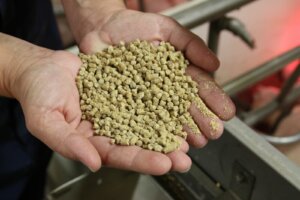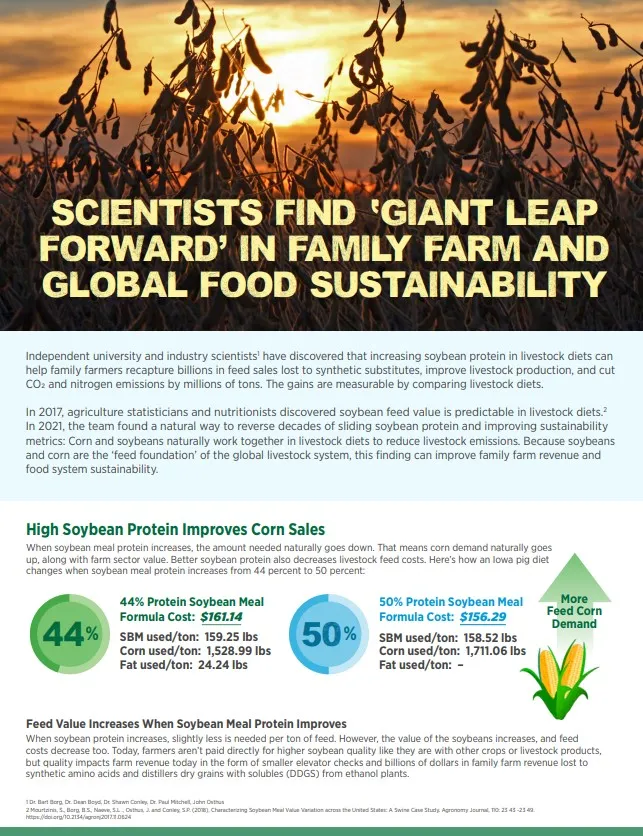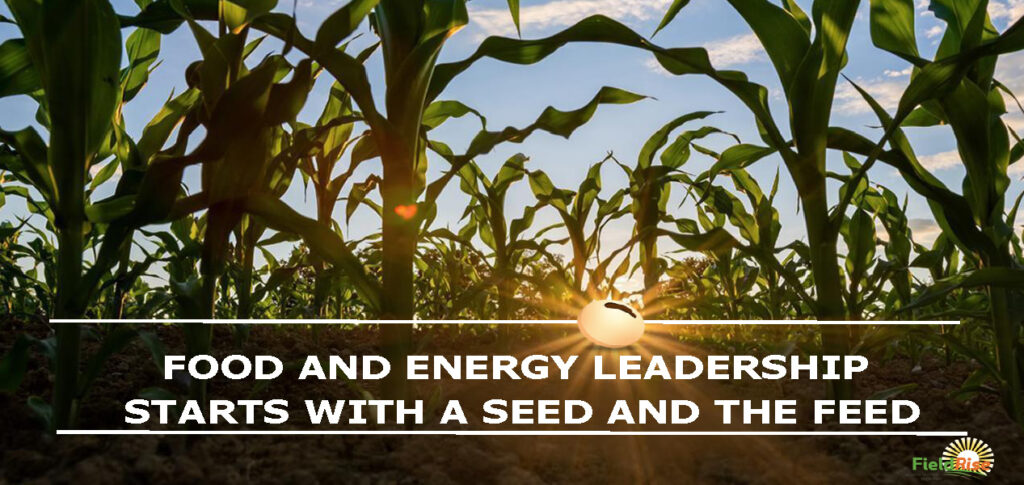Below is a collection of research materials related to the work done by our science team. We will continue to add new materials, as they are identified, so check back often.
Please feel free to contact us for more information about any of our scientific endeavors.
Natural Feed Reduces Livestock GHGs
Since 1990, distillers dried grains with solubles and synthetic amino acids have replaced soybeans and corn in livestock feed. This trend impacts lifecycle greenhouse gas emissions from livestock production, in addition to family farm revenue. A 2020 Argonne laboratory study found greenhouse gases and carbon intensity are significantly higher with synthetic feed compared to natural ingredients. This finding matters to sustainability managers because about 90% of GHG emissions from pigs and poultry come from producing the feed.
Characterizing Soybean Meal Value Variation across the United States: A Swine Case Study
by Spyridon Mourtzinis, Barton S. Borg, Seth L. Naeve, John Osthus, and Shawn P. Conley
Abstract: Soybean [Glycine max (L.) Merr.] is the most important oilseed crop in the United States; however, the quality characteristics of the soybean meal (SBM) produced from soybean grown in various regions can vary significantly, often leading to region-specific commodity price differentials. Currently, a fast, cost-effective, and accurate estimation method of SBM value does not exist. Our objectives were to (i) develop a model using existing data that precisely estimates SBM value targeted for swine nutrition, (ii) quantify the swine-specific SBM value variability within and among states and (iii) evaluate the predictive effectiveness of the model for estimating SBM value. The compositional characteristics of 8282 soybean samples from 2013 to 2016 in 29 states were determined. Assuming constant energy content, considering meal protein content and the concentrations of four essential amino acids (AA) (lysine [Lys], methionine [Met], tryptophan [Tryp], and isoleucine [Iso]) from these samples, a model that precisely estimates swine-specific SBM value was developed. Within each state, US$17 to $66 t–1 SBM value range was estimated. A model based on combined and maturity group-specific analysis showed that using a simple base-line seed content of >350 g kg–1 for protein and >190 g kg–1 for oil to identify high-quality cultivars can be misleading and that the proposed model can estimate swine-specific SBM value more precisely, both locally and regionally. This method can also be used for other, economic important animal diets (e.g., poultry) which could help U.S. soybean producers choose high-yielding cultivars that are more likely to produce seed with increased ration-specific SBM value.
Quantifying the value of soybean meal in poultry and swine diets
by M. Pope, B. Borg, R. D. Boyd, D. Holzgraefe, C. Rush, and M. Sifri
Summary: The soybean supply chain incentivizes upstream participants (farmers) to maximize crop yield (volume), while downstream participants (nutritionists) make decisions based on crop quality characteristics such as amino acid concentration and energy content. These parameters tend to decline as soybean yield increases, consequently, the value proposition for soybean meal (SBM) is not fully recognized in the market. Furthermore, on a global basis, SBM sales are based primarily on minimum crude protein (CP) content, which does not fully account for the true value of SBM to the end user. In this study, a systematic framework was developed to quantify SBM value in both poultry and swine diets using the nutritional attributes (digestible amino acids and energy) that are the primary determinants of end-user value. To demonstrate the application value of soybean meal and its nutrient composition, SBM samples were analyzed for moisture, CP, and 11 amino acids. These values were then regressed to estimate 5 SBM CP concentrations (44.0, 45.0, 46.0, 47.0, and 48.0% CP) and the corresponding energy, and then used in a formulation exercise. Least cost diet formulation software calculated the cost of diets for poultry and swine for the 5 SBM CP concentrations. For each scenario, the only change allowed during the least cost optimization was the individual CP concentration of SBM. Relative SBM value was calculated based on SBM use (kg), total diet costs ($/MT) and current market ingredient prices ($/MT) for the diet formulas. The results showed that for each 1% increase in SBM CP concentration from 44.0 to 48.0% (or each 0.065% increase in total lysine from 2.75 to 3.01%) the SBM value increased on average $10.27 for swine and $12.62 for poultry per metric ton of feed. This analysis ties incremental changes in product nutritional composition (amino acid content and energy) to an increase in value of SBM ($/MT) for swine and poultry diets, and quantifies value from the end-user (nutritionist) perspective, allowing alignment across the value chain.
Increasing Soybean Meal Protein Level Reduces GHG Emissions (poster)
Soybean [Glycine max (L.) Merr.] is the most important oilseed crop in the United States. However, soybean protein content has been declining for decades, and a comprehensive ecosystem-based approach to address that decline does not exist. Furthermore, feed production comprises about 90 percent of greenhouse gas emissions from pig and poultry production, so improving soybean meal protein has significant farm revenue and emissions implications.
Scientists Find Giant Leap Forward in Family Farm and Global Food Sustainability (brochure)
Independent university and industry scientists have discovered a breakthrough way for farmers and food companies to improve farm sector revenue and food sustainability GHG metrics, starting with soybean variety selection. In 2017, agriculture statisticians and nutritionists developed a way to know which soybeans have the highest nutritional value in live stock feed. In 2021, the team pieced separate data together and found a hidden secret to reversing decades of sliding soybean protein and improving sustainability metrics: Corn and soybeans naturally work together in livestock diets to reduce livestock GHG emissions. Because soybeans and corn are the ‘feed foundation’ of the global livestock system, this finding can help improve future family farm revenue and food system sustainability.
Food and Energy Leadership Starts with a Seed and the Feed (presentation)
KEY POINTS COVERED
- Consolidate and quantify sustainability, carbon footprint, nitrogen, and protein availability to move beyond commodity basis.
- Science is available but not implemented – Yet.
- The global food supply can be improved with management of natural protein within current agriculture system (soybeans for protein; grains for energy).
- Encourage best management practices to reward quality standards without losing tons.
- Science team “asks” to support USDA mission success
The Potential Impact of Animal Science Research on Global Maternal and Child Nutrition and Health: A Landscape Review
Abstract:
High among the challenges facing mankind as the world population rapidly expands toward 9 billion people by 2050 is the technological development and implementation of sustainable agriculture and food systems to supply abundant and wholesome nutrition. In many low income societies, women and children are the most vulnerable to food insecurity, and it is unequivocal that quality nutrition during the first 1000 d of life postconception can be transformative in establishing a robust, lifelong developmental trajectory. With the desire to catalyze disruptive advancements in global maternal and child health, this landscape review was commissioned by the Bill & Melinda Gates Foundation to examine the nutritional and managerial practices used within the food-animal agricultural system that may have relevance to the challenges faced by global human health. The landscape was categorized into a framework spanning 1) preconception, 2) gestation and pregnancy, 3) lactation and suckling, and 4) postweaning and toddler phases. Twelve key findings are outlined, wherein research within the discipline of animal sciences stands to inform the global health community and in some cases identifies gaps in knowledge in which further research is merited. Notable among the findings were 1) the quantitative importance of essential fatty acid and amino acid nutrition in reproductive health, 2) the suggested application of the ideal protein concept for improving the amino acid nutrition of mothers and children, 3) the prospect of using dietary phytase to improve the bioavailability of trace minerals in plant and vegetable-based diets, and 4) nutritional interventions to mitigate environmental enteropathy. The desired outcome of this review was to identify potential interventions that may be worthy of consideration. Better appreciation of the close linkage between human health, medicine, and agriculture will identify opportunities that will enable faster and more efficient innovations in global maternal and child health. Adv Nutr 2017;8:362–81.
Keywords: global health, growth stunting, animal models, pregnancy, lactation, fatty acids, amino acids, zinc, iron, phytase
What global maternal and child nutrition can learn from animal science
The main challenges to ensuring optimal nutrition of children in low-income and middle-income settings are prevention of undernutrition—including intrauterine growth restriction, stunting, and micronutrient deficiencies—and avoidance of becoming overweight. Birth cohort studies show that linear growth in early life is associated with improved human capital (including intelligence, educational performance, and productivity) and has few, if any, deleterious effects regarding future risk of non-communicable diseases. By contrast, rapid weight gain, above and beyond what is required for linear growth, does not confer any benefits in terms of human capital and is associated with an increased risk of chronic diseases.2 Early undernutrition followed by exposure to an obesogenic diet in later childhood seems to result in especially poor outcomes. Ensuring that young children achieve optimal linear growth without putting on excessive weight represents a major challenge to public health and nutrition.











